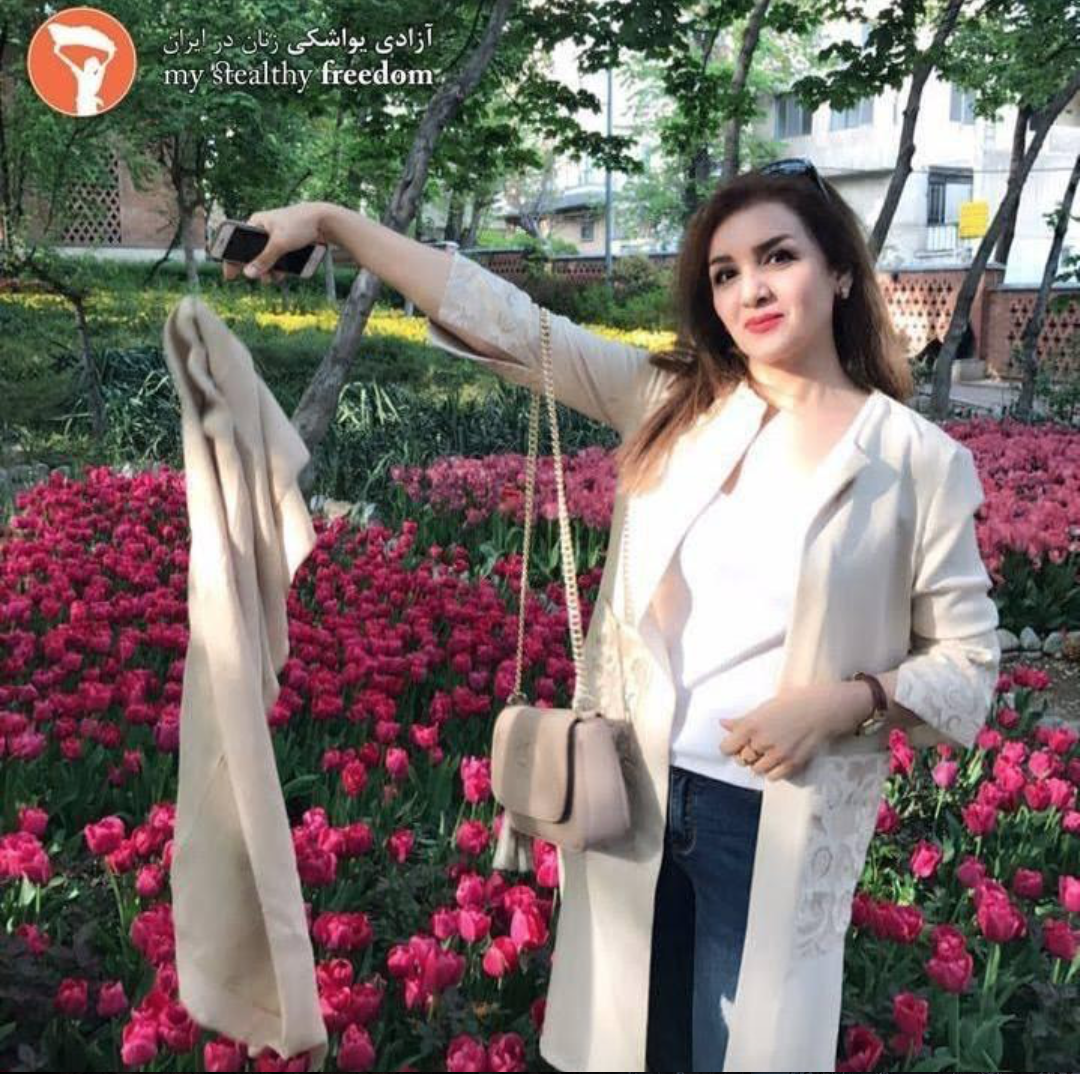
An Iranian woman shows her support for White Wednesdays campaign by carrying a white scarf.
Source: My stealthy Freedom Facebook Page
A new campaign designed to challenge the compulsory hijab law in Iran is encouraging women to show their support by wearing white headscarves in public every Wednesday.
The campaign, now in its seventh week, was launched by Masih Alinejad, the founder of the successful Facebook page My Stealthy Freedom which provides a platform for Iranian women to post their hijab-less “selfies” in defiance of the Iranian authorities. The page has over one million subscribers.
Since the campaign’s launch, many women have posted videos and photos of themselves wearing or carrying white headscarves on Wednesdays.
Alinejad hopes her campaign to become “a symbol of free choice and the relentless battle for equality” in Iran.
Alinejad has made it clear that the campaign is not against the hijab but its imposition on women, and as such, is also open to Hijabi women who believe in women’s freedom to choose.
Looking at the photos and videos posted online, it appears that some Iranian men are also getting behind the campaign by wearing white clothing on Wednesdays.

Iranian women are defying the hijab law by removing their headscarves and posting their photos on social media. Source: My stealthy Freedom Facebook Page
Although a sizable group of Iranian women voluntarily wear the hijab, others have long opposed the post-revolution hijab law.
In 2014, a string of acid attacks on Iranian women in the city of Isfahan terrorized “bad hijabis”- the term for women who fail to observe the strict Islamic dress code (wearing tight clothing, showing some hair, wearing makeup, etc.).
The attacks attracted widespread protests from citizens who demanded better security and actions against such violent crimes.
With the possibility of acid attacks and punishment for failing to observe the hijab law ranging from lashes to imprisonment, those who are joining the White Wednesdays campaign are clearly bolstered by the recent re-election of President Hassan Rouhani and his promises for greater freedom and reform.
Hijab has long been an instrument of political power in Iran.
In 1936, Reza Shah, the father of the former Shah of Iran banned women from wearing any form of head covering in public.
The unsuccessful ban, rather than emancipating women as it was intended, effectively imprisoned women in their own homes as many women refused to appear in public without their hijabs.
The forced Westernisation of Iran and lack of respect for traditional and tribal values contributed to the 1979’s popular revolt and the transformation of Iran’s political and civil system.
The post-revolution referendum held on 30 and 31 March 1979 led to the creation of the Islamic Republic and, subsequently, the removal of many of women’s basic rights including the right to dress freely.
Women had actively participated in the, initially, secular revolution to bring democracy and greater political freedom to their country but alas the word “democracy” was nowhere to be seen on the post-revolution ballet paper.
The yes-or-no question in the 1979 referendum simply asked whether the monarchial system should be changed to the Islamic Republic of Iran.
At the time, many groups, rightly, objected to the wording of the question and demanded alternate choices such as: “People’s Republic of Iran” or “Democratic Islamic Republic of Iran”.
But the then leader of the Iranian revolution, Ayatollah Khomeini’s response was unequivocal. He insisted that the word “democratic” was Western and that the word “Islamic” was closer to the people’s aspiration for complete independence from the West. “What the nation wants is an Islamic Republic, not one word more and not one word less”, Khomeini said.

An Iranian grandmother (left) and her sister say they support the campaign because they believe in women’s right to take or leave the hijab. Source: My Stealthy Freedom Facebook Page
The high turnout (98% of eligible voters) and even higher ‘yes’ vote (99.3%) came as no surprise. There was an incredible, and in hindsight, naïve euphoria in the months following the victory of the revolution and the clergy wasted no time to cement their power by taking advantage of the anti-Shah sentiments that had galvanized people together.
I was too young to be allowed on anti-hijab protests that followed Khomeini’s decree for mandatory hijab, but my older female cousins joined a sea of women protesters who marched on streets of Tehran in opposition to the new hijab law.
The protests received little support from the Iranian men who argued strongly for the importance of unity against the national and international enemies of the fragile revolution.
With so much blood spilt for the revolution, a little scarf over women’s heads seemed, at the time, a trivial price to pay for the successful continuation of the revolution- or so thought the men.
To this day, I often wonder if the Iranian women would have still voted for the Islamic Republic on that crucial 1979 referendum, had they known they would be constantly harassed and abused on the streets by the morality guards for their bad hijabs.
Would they have voted ‘yes’, had they known they would need their father or husband’s permission to be able to travel abroad?
Would they have wanted an Islamic Republic where their testimony in court, when they were allowed to give one, would carry half the weight of a man’s testimony; and the custody of their children would automatically go to their husbands; and they would face unequal inheritance rights, and restrictions in attending sport events both as athletes and spectators?
I think the answer to all those questions is a resounding no.
There is a proud history of feminist movement in Iran that dates back before the first ever women’s convention in United States in 1848.
An Iranian poet and writer Fatimah Baraghani, known as Tahereh (meaning the pure one), reached infamy in early 1840s by removing her veil in a gathering of men, an act which, together with her outspoken liberal views, ultimately led to her murder.
Roll forward to 2017 and once again women are unveiling themselves at great risks to themselves to bring greater freedoms to Iran- but the question remains: could White Wednesdays be the catalyst for change; or would it strengthen the hand of hardliners who would argue that Rouhani’s moderate government is opening the door to Western decadence?
Only time will tell.






We are all born equal, so I support these women as equals.
So should the Islamic Republic abide by this logic right of every human right to flourish.
I am a man that wishes for the day when we are all truly equally treated.
I have always wondered about whether wishing for equal treatment is a good thing. After all, the majority of the male folks don’t always have it so good either. Maybe we should strive for justice rather than equality.
So on one hand you agree with womens rights NOT to wear a hijab (if they dont want to) but have no problem with the burka in weatern society as it’s ‘their choice’? Always assumming of course the burka wearers husband/father is not making them wear one in western countries…some consistancy would be nice. Are you for or against islamic religious garb on women?
Although I agree with sentiments of the article I feel them rather trivial compared to the other theocracy based abuses of human rights in Iran.
Such as the anti homosexuality laws and its brutal punishments, the same applying to adultery, blasphemy, and (until recently?) the inclusion of stoning to death as punishment in the penal code.
I would like to see the burqa and the niqab banned in NZ in public. I have never believed that it can be the real choice of women to cover their faces, but more about control of women and the lack of control by men. Endless indoctrination. Should I travel to a country where I am required to cover my body up of course I will obey the laws of that country or take the consequences. Personally I find it hard to believe that any child moving to NZ will wear the niqab or the burqa out of personal choice when she becomes older. One of the things I don’t understand is how women driving can have peripheral vision when wearing this garb. Scarves, long dresses covered arms entirely okay.
Michal, can you spot the contradiction in your comment above?
Comments are closed.